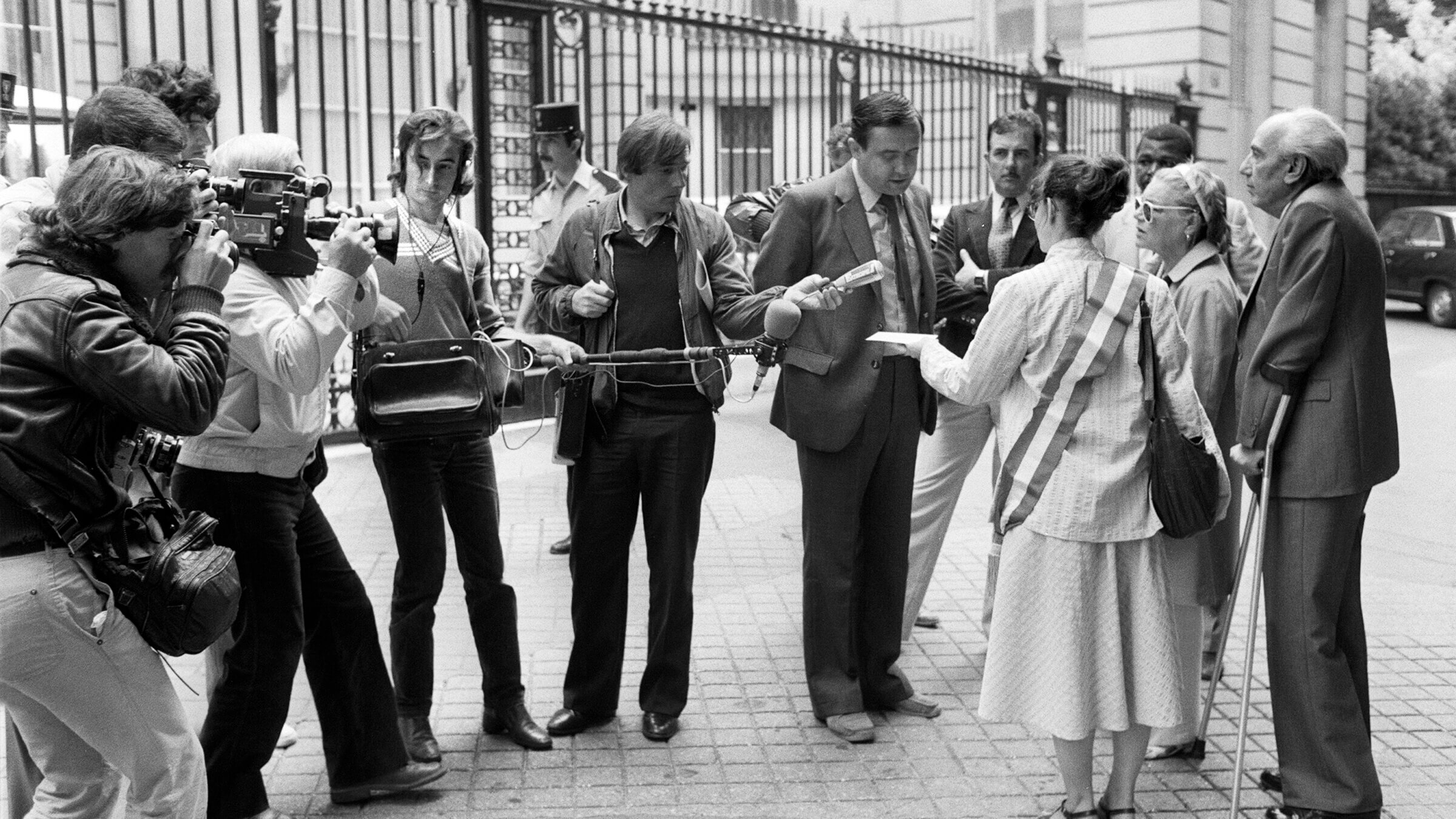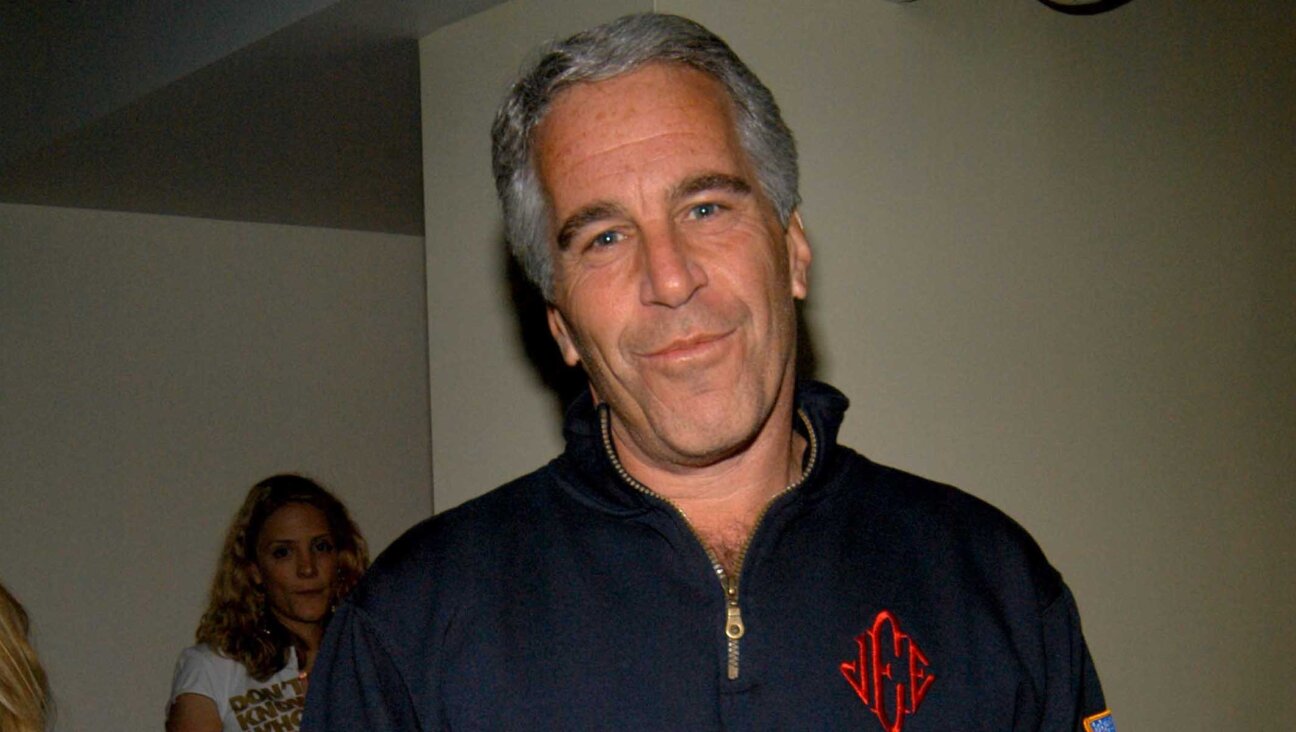In the shadow of the Holocaust, a new Kafkaesque nightmare for Jews in Czechoslovakia
70 years ago, 10 Jews were executed after the antisemitic Slánský trial

French actress Simone Signoret, second on right, and Artur London, far right, protest against political repression of Czech dissent, 1981. London was one of three men who did not receive a death sentence in the Slansky trial. Photo by Getty Images
This month marks the 70th anniversary of the infamous Slánský trial, a 1952 antisemitic show trial against Communist Party members in Czechoslovakia. Ten defendants of Jewish origin, including Rudolf Slánský, a formerly powerful Czech Communist politician, were among the 11 prisoners finally executed.
Raphael Lemkin, the Polish Jewish attorney who coined the term “genocide,” considered the Slánský trial an example of judicial murder. It was deemed a “bizarre vaudeville” by Czech novelist Josef Škvorecký for its specious charges and entirely scripted content. More recently, writers and filmmakers have been evaluating how East European Jews, who had narrowly escaped the Holocaust, responded to this new public assault.
After Slánský was hanged, other Jews in public life prudently refrained from protesting. After all, if this could happen to a mighty political leader, it could happen to anyone. A number of true believers in progressive politics, who considered that the only choice was between communism and fascism, continued to put faith in the former as long as possible.
And so the German Jewish economist Jürgen Kuczynski explained that antisemitism prevalent in Eastern Europe was forced on well-meaning socialist political leadership by the USSR. In fact, several home-grown Czech antisemites were vocal about their prejudices, like the politician Václav Kopecký, who in a 1947 speech referred to Jews as “bearded Solomons” who falsely claimed to have participated in anti-Nazi wartime resistance. Yet the German Jewish author Arnold Zweig wholly dismissed the notion of any antisemitism in communist countries as “Western propaganda.”
A newly published study, “Jewish Lives Under Communism,” underlines how postwar families, trying to create new lives after they had been decimated by wartime carnage, clung to the hope that conditions would somehow improve, despite the looming presence of ever-more vehement antisemitism.
And so the Bulletin of the Jewish Community in Prague, the only journal with information about Yiddishkeit published in Communist Czechoslovakia, discreetly omitted any mention of the Slánský trial. Yet in November 1952, after death sentences were handed out to Slánský and nine other defendants of Jewish origin, for the first time the Bulletin listed examples of admirable local Jewish workers. One of the contrived accusations against Slánský and his fellow accusees was that, as Jews, they were idle bourgeois internationalists, failing to contribute any useful labor to the socialist state.
In this context, the Bulletin found it timely to praise Jewish so-called “shock workers” in chemical factories. This term, borrowed from Soviet propaganda (udarniki), referred to highly productive laborers in the Eastern Bloc who exceeded production quotas. There was even the Soviet honorary title of Shock Worker of Communist Labor. Following this trend, the Bulletin noted that Heřman Herškovič, the Jewish worker in question, had survived “several concentration camps” and his wife and eight children had been murdered in Auschwitz, but he emerged to toil ardently to advance the socialist state.
Alas, this type of exemplary diligence convinced few dyed-in-the-wool Eastern European antisemites. At the time, governments criminalized those who merely sympathized with Jews, as well as those with Jewish ancestry. In the wake of the Slánský trial, Paul Merker, a non-Jewish German politician, was arrested as a spy because he had advocated for financial restitution for Jewish Holocaust survivors. Merker also supported the creation of the state of Israel. Indeed, Merker was so enthused by Jewish causes that a number of his contemporaries were convinced that he must be Jewish himself.
Official justification for this viewpoint was expressed in 1953, when East German newspapers concluded that the Slánský trial had usefully exposed criminal activities related to “Jewish nationalism” that served the interests of “Jewish capitalists.” The German Jewish journalist Heinz Brandt, an Auschwitz survivor, recalls hearing a fellow socialist activist saying that the Slánský Trial had “absolutely nothing to do with racist antisemitism” because most Jews, being from relatively comfortable lower-middle-class origins, had no social connections with the working class, but did have lots of friends and relatives in the West. Communist ideology condemned Jews as disloyal cosmopolitans and exemplars of bourgeois culture.
Under the circumstances, politically active Eastern European Jews carefully concealed their Jewish roots. For instance, consider the diarist Victor Klemperer, son of a Reform rabbi, whose communist beliefs were ultimately shaken by the crushing ambient antisemitism of public life. Klemperer jotted down in his journal in August 1955: “I grieve about my blindness … a Jew, an undefined liberal in a society that did not respect me; I am today in a society that disrespects me.”
This vivid sense of remorse is also reflected in Ruth Zylberman’s documentary “The Trial — Prague 1952,” which premiered in France earlier this year. It is based on interviews with surviving family members of the executed Slánský trial defendants as well as historical courtroom footage long forgotten and rediscovered four years ago in a warehouse outside Prague. This evidence, especially as interpreted by historians, brings us closer to the actual events, which had previously been fictionalized in “The Confession,” a 1970 film surrounding the events of the Slánský trial, starring the French Jewish actress Simone Signoret (born Kaminker).
Posterity also presented some unexpected real-life ironies; when Vaclav Havel was elected president of Czechoslovakia, he named Rudolf Slánský’s son, a dissident during Communist rule, as Czech ambassador to the Soviet Union. An even more trenchant juxtaposition was the example of the literary critic and Kafka specialist Eduard Goldstücker, called to testify against Slánský at the trial. It has become commonplace to describe the Slánský trial, rife with vague, nightmarish, and false allegations, as Kafkaesque. But the full connection with Kafka was overlooked until it was illuminated by Veronika Tuckerová of Harvard University.
In an insightful article, Tuckerová explains how Goldstücker, of Slovakian Jewish origin, responded to antisemitic pressure by castigating Slánský as a spy for the West. Among Goldstücker’s recollections was that in 1946, Slánský had advised him to change his name to the less Jewish-sounding Zlatistý (meaning “golden” in Czech) to facilitate career advancement. Oddly, after enduring this episode professionally and becoming influential in deciding which works of Western literature would be published in communist Czechoslovakia, Goldstücker, despite being a renowned Kafka specialist, actually prevented the appearance of Kafka and other Western literature in Czech translation.
In 1963, at the same time as he convoked a major literary conference in Czechoslovakia in honor of Kafka to increase his own academic prestige, Goldstücker was “hindering the publication of Kafka” by writing negative expert evaluations of his work for a Czech publisher, according to the philosopher Ivan Dubský.
In a murky, self-contradictory way that some European Jews tried to justify or deny the existence of Stalinist antisemitic persecution in the name of defending anti-fascism, the way Goldstücker promoted, while simultaneously suppressing, Kafka might be expected in a world where basic aspects of logic were overturned on a daily basis. For Jews living under the yoke of communism, the Slánský trial was a nightmare, but tragically par for the course as a low point in 20th-century European Jewish experience.





















